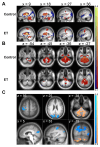Thalamic and Visual Network Dysfunction Relates to Tremor Response in Thalamic Deep Brain Stimulation
- PMID: 40756066
- PMCID: PMC12315681
- DOI: 10.5334/tohm.1039
Thalamic and Visual Network Dysfunction Relates to Tremor Response in Thalamic Deep Brain Stimulation
Abstract
Background: Essential tremor (ET) is the most common movement disorder in adults, but its pathogenesis is incompletely understood. Deep brain stimulation of the ventral intermediate thalamic nucleus (VIM DBS) provides effective treatment for medically-refractory cases. We aimed to determine how pre-surgical resting-state functional connectivity (FC) in medically-refractory ET relates to VIM DBS clinical response.
Methods: We analyzed resting-state FC MRI in 21 participants with medically-refractory ET who subsequently underwent VIM DBS and 34 matched controls. We applied rigorous quality assurance to minimize motion artifact. Whole-brain correlation matrices were computed across 300 cortical, subcortical, and cerebellar regions and compared across groups using object-oriented data analysis, a powerful novel approach. We used multiple linear regression to determine whether network FC (calculated as mean cross-correlation between nodes) in defined networks predicts VIM DBS response. We assessed regional FC using a seed in motor thalamus.
Results: Whole-brain correlation matrices and regional motor thalamus FC differed significantly between groups. Post-hoc network-level testing revealed decreased thalamus-somatomotor, thalamus-visual, and auditory-visual FC in ET versus controls. Regional FC showed increased primary motor cortex and decreased occipital-parietal and cerebellar FC with motor thalamus in ET relative to controls. Visual-lateral somatomotor network FC negatively predicted tremor improvement with VIM DBS.
Discussion: Whole-brain, network, and regional FC results demonstrate cerebello-thalamo-motor pathway dysfunction in ET. Robust FC differences in motor and visual regions related to VIM DBS outcomes. These results, employing rigorous quality control, support the need for additional investigation into the role of visual cortical networks in ET and DBS response.
Keywords: Essential tremor; functional connectivity; resting-state fMRI.
Copyright: © 2025 The Author(s).
Conflict of interest statement
The authors have no competing interests to declare.
Figures




Similar articles
-
Connectivity derived thalamic segmentation in deep brain stimulation for tremor.Neuroimage Clin. 2018 Jan 28;18:130-142. doi: 10.1016/j.nicl.2018.01.008. eCollection 2018. Neuroimage Clin. 2018. PMID: 29387530 Free PMC article.
-
Hyperconnectivity and Connectome Gradient Dysfunction of Cerebello-Thalamo-Cortical Circuitry in Alzheimer's Disease Spectrum Disorders.Cerebellum. 2025 Feb 6;24(2):43. doi: 10.1007/s12311-025-01792-4. Cerebellum. 2025. PMID: 39913059
-
Wearable peripheral nerve stimulator reduces essential tremor symptoms through targeted brain modulation.Brain Stimul. 2025 Jul-Aug;18(4):1162-1173. doi: 10.1016/j.brs.2025.06.004. Epub 2025 Jun 6. Brain Stimul. 2025. PMID: 40484122
-
Ventral Intermediate Nucleus of the Thalamus versus Posterior Subthalamic Area: Network Meta-Analysis of DBS Target Site Efficacy for Essential Tremor.Stereotact Funct Neurosurg. 2022;100(4):224-235. doi: 10.1159/000522573. Epub 2022 Mar 29. Stereotact Funct Neurosurg. 2022. PMID: 35350022
-
Deep brain and cortical stimulation for epilepsy.Cochrane Database Syst Rev. 2017 Jul 18;7(7):CD008497. doi: 10.1002/14651858.CD008497.pub3. Cochrane Database Syst Rev. 2017. PMID: 28718878 Free PMC article.
References
MeSH terms
LinkOut - more resources
Full Text Sources
Miscellaneous

